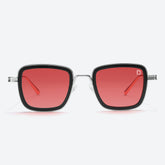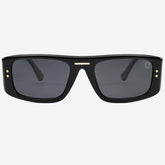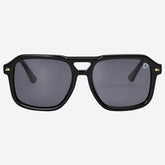What Is The Difference Between Single Vision And Progressive
With prescription lenses, there are two major types; single-vision lenses, and progressive lenses. Do you know the differences between these lenses? Do you know which would best suit your needs? In this article, we’ll discuss these two lenses; single vision vs progressive—breaking down all the jargon, so you can understand them better.
Single vision: definition
The most common type of prescription lenses are the single vision prescription lenses. These lenses correct just one type of distance-related eye defect by design. So, the lenses have a design that either corrects farsightedness, shortsightedness, or astigmatisms. Another way to describe these lenses is to say that they provide a corrective vision for reading, distance, or while working behind a screen.
Progressive lenses: definition
To understand the differences between progressive lenses vs single vision, we also need to understand what progressive prescription lenses are. Progressive lenses are lenses that can meet the needs of people with more than one distance-related eye prescription. Such lenses can correct farsightedness, nearsightedness, and every other thing in between. They provide distance vision, intermediate vision, and close-up vision without needing to change eyeglasses each time.
Progressive prescription lenses are a form of multifocal lens, similar to bifocal lenses. The difference is that the vision transitions more seamlessly, evidenced by how no lines demarcate the different vision zones as you would find with bifocals. Usually, the top part of the lens is for distance vision, the bottom part is for reading, and the middle part provides intermediate vision. Other names for progressive lenses include multifocal, “no-line” trifocals, varifocals, or progressive addition lenses (PAL for short).

What is the difference between single vision and progressive?
The difference between regular lenses (single-vision lenses) and progressive lenses is in their designs and functionalities. Single-vision lenses have only one focal length, so they only correct one vision impediment. Progressive lenses are designed to have multiple focal lengths so that they can correct multiple vision impediments.
Progressive glasses are for people who need more than one type of prescription lenses, saving them the cost and energy of always having to swap multiple eyeglasses for different tasks. Meanwhile, single-vision glasses are for people with only one vision issue and require lenses with only one prescription remedy.
How Do Progressive Lenses Work?
Progressive lenses have three different zones for vision; distance sight, intermediate, and closeup. However, rather than have these zones distinctly separated, they all merge into each other “progressively”—now you understand the name!
The top part of the lens is where you view objects at a distance, and this is easy, as you just need to look straight ahead. The middle part is for intermediate views, like when you’re using your computer. This view is just below your eye level. The bottom part is for the closeup view and is useful for reading and other activities that require nearsightedness.
How Do Single Vision Work?
Single-vision lenses have a design that provides a remedy for people with farsightedness (hyperopia), age-related farsightedness (presbyopia), or nearsightedness (myopia). These issues occur because the lenses inside their eyes cannot adjust properly for them to see objects at these distances. Depending on the design, these lenses converge or diverge the light rays entering the eyes, so they enter at an angle at which the eyes can process them properly. Through its distance correction, a single-vision lens reduces the strain on the eyes and increases their focusing ability.

Who Should Wear Progressive Glasses?
Still on our discussion on single vision vs progressive lenses, let's look at those who need progressive glasses. The most common people who use progressive glasses are people suffering from presbyopia. Presbyopia is an eye condition that results in a person being unable to focus on near objects. This differs from hyperopia because it is age-related, unlike hyperopia.
It is caused by the eye lenses thickening, and the surrounding muscles weakening, resulting in an inability to readjust properly to bring near objects into focus. So, near objects appear blurry. Presbyopia usually starts showing symptoms when a person clocks 40, or thereabouts.
However, people with presbyopia aren’t the only ones who use progressive prescription lenses. Younger patients who have eye-focusing issues can also use them.
Single vision vs progressive: Which is better?
Ultimately, in the discussion of progressive lenses vs single-vision lenses, none is really better than the other. It all depends on factors like your eye condition, lifestyle, money, and prescription. However, let's look at the advantages and disadvantages of progressive lenses and single-vision lenses, respectively.
Progressive Lens Benefits
-
You only need a pair of prescription lenses
With progressive lenses, you don’t have to keep changing eyeglasses for different activities like sitting in front of a computer screen, reading, or any other activity. This also means less baggage to carry around and fewer chances of misplacing a pair of eyeglasses. Your one prescription eyeglasses is enough for everything.
-
Transitioning between lens powers is more seamless
If you use a bifocal lens, moving your eyes from one lens to the other can create a temporary distortion of the position of the object you’re viewing. Basically, it looks like the image “jumped” a little as you moved from one lens to the other. Since progressives have a design that blends the different lens powers seamlessly, you don’t experience such image jumps.
-
Progressives can improve your posture and even help against computer vision syndrome.
Bifocal lens users have to keep moving their heads as they switch from one lens to another to use the ideal lens for viewing an object. With progressive lenses, you don’t have this issue, and this is good news for your posture.
-
Progressives don’t draw attention to themselves or your age.
One common marker that gives away how old they are is their eyeglasses. Seeing someone wearing a bifocal lens can immediately hint they’re probably in their forties. Not everyone likes this giveaway, and the simple solution is getting a pair of progressives. These just look like a normal pair of prescription glasses, so there’s no hint of your age.
Progressive Lens Disadvantages
-
Requires adjustment time
When you first start using progressive lenses, you will need some time and practice to adapt to using them. That’s because you have to learn to use the different areas of the lenses to view different distances. Expect some nausea or dizziness, and distorted peripheral vision at the beginning. However, these side effects should go away after a couple of weeks.
-
More expensive than other multifocal lenses.
Progressive prescription lenses cost more than bifocal or trifocal lenses. So, if you’re on a budget, it may seem like an expensive option. However, considering their design and functionality, they over more value for money.
-
Limited options
If you have a stronger prescription, you may not get certain frame styles. For instance, progressives may not fit well in a rimless or semi-rimless frame.
-
Peripheral distortion
We already mentioned peripheral distortion earlier. However, choosing quality lenses can minimize this issue.

Single Vision Lenses Benefits
-
Improved Visual Clarity
Single-vision lenses provide its wearer with improved vision. They’re effective remedies for people with visual impediments.
-
Enhanced Focus
Single-vision lenses also enhance focus on objects. This is important for activities like sports, reading, and driving.
-
Customized Options
Perhaps, the most noteworthy benefit of single-vision glasses is how highly customizable they are. The lenses can be made with different materials, have different coatings, and come in different frames.
-
Easy to Use
Finally, they’re simple and easy to use. Your eyes don’t have to keep adapting to different focal zones on the lens, as there’s only one focal zone throughout the lens.

Disadvantages of Single Vision Lenses
-
Fixed focal length
Single vision lenses have just one focal length, so, they only address one eye issue (either near vision or distant vision). If you require more than one prescription lenses, you will need to have more than one pair of eyeglasses.
-
Not optimized for peripheral vision
Single-vision lenses do not have the best peripheral vision. This is because vision correction is usually limited to the front part of the lenses. This may be an issue when engaging in an activity that requires an optimal awareness of your surroundings, like sports or driving.
-
Inadequate depth perception
Finally, Single vision lenses do not provide optimal depth perception. This may be an issue if you engage in activities—like manual labor or sports—that require an accurate judgment of depth and distances.
Tips of progressive lenses and single vision
Now that we’ve compared progressive lenses vs single-vision lenses, let's discuss tips for using your prescription glasses, whether progressive or single-vision.
- Learn how to aim your head in whatever direction you wish to look, instead of just your eyes. This is because moving your eyes may cause them to move into different zones of the lens too quickly for it to adjust properly. As a result, it may put some strain on your eyes, and meddle with your vision.
- Look straight ahead whenever you walk, rather than down at the ground. These lenses can distort your view of the ground—especially if you use a progressive lens since their bottom parts are for close-up views.
- Wear your lenses as often as possible, to allow your eyes to get accustomed to them. You should also watch for any form of discomfort as you use them, or if using them causes your vision to be distorted. If you notice any of these, stop using the eyeglasses, and consult your optician immediately.
- Finally, always adhere to every advice and instruction your doctor gives you. This will ensure you get the most out of your prescription glasses. Also, as we said earlier, do not hesitate to inform them if you notice any trouble adapting to your new lenses.
Conclusion
And that wraps up our discussion on progressive lenses vs single vision. Both are excellent choices for anyone who opts for them. They also both have their drawbacks. So, it all boils down to prescription, functionality, and choice. However, we can assure you that no matter your choice, both are lenses that’ll provide remedy and comfort to your eyes.





